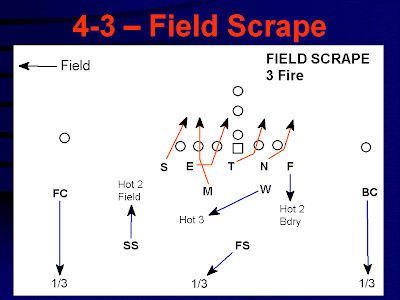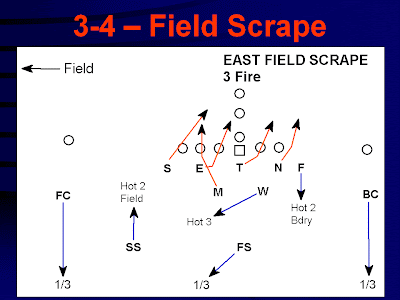I will try to build on the superb efforts of Brophy’s Manny Diaz: Bulletproof Fire Zone article and talk more about Diaz's Fire Zone scheme, which is ridiculously simple to learn for his players yet is complex for opposing Offensive Coordinators. I will focus on two important aspects of his Fire Zone scheme. First, I will look at how he is able to transition easily between multiple fronts and second, I will explain his “run to daylight” philosophy.
Multiple Fronts
There may not seem like much of a difference between the 4-3 and 3-4 fronts, but they represent two different paradigms in the universe of defensive football. Each front requires significant time to teach its defensive linemen the necessary technique. The time constraints are such that most coaches don’t try to play both. I would say that Diaz is a 4-3 guy who dabbles in the 3-4, but he doesn’t try to do too much with it, which is important.
The 3-4 lends itself better to Fire Zones, with 4 LBs who can move around more in the 3-4 pre-snap than the 3 LBs in the 4-3. Diaz prefers to Fire Zone from the 3-4 because the DE who drops in coverage “has eyes”—being away from the line with his hand off the ground allows him to see and better defend the pass.
Diaz has the ability to run his Fire Zones easily from either side due to his simple rules that tell the DL how to line up and where to slant to. Diaz doesn't call a front in the 4-3 (one less word in the play call so as not to confuse his players), the DL will simply line up away from the call and slant away from the call. Field Scrape (below) is run from the 4-3 front. “Field” means that the Scrape Fire Zone will be run to the wide side of the field. The DT (always on the left) and NT (always on the right) can start up head up on the Guards and then they can adjust their alignment away from the call and slant away from the call. “Field” also tells the Safeties that they will rotate towards the Field.
In Bench Scrape (below) from the 4-3 front, the Scrape Fire Zone is now being run to the Bench, or the short side of the field (closest to the bench on the sideline). The DL will line up and slant away from the call and the Safeties will rotate to the Bench.
East and West are Diaz’s 3-4 fronts. West shifts the DL to the wide side of the field and East shifts them to the short side of the field. One DE will be aligned as an OLB. His alignment off the ball improves his vision to help him to better defend the pass. East Field Scrape (below) is from the 3-4 front to the wide side of the field. The DL will line up according to East or West, and then they will slant away from the call like they always do. Field Scrape (4-3) and East Field Scrape (3-4) are the exact same thing, the only thing that changes is how the front lines up.
West Bench Scrape (below) is the 3-4 version to the short side of the field and is the same thing as Bench Scrape from the 4-3:
Diaz can also go show a 3-3 Stack look (below), which really “melts the computers,” of opposing OCs. He can easily go from the 3-4 to the 3-3 by making a “Freedom” call to the drop DE, which tells him that he has the freedom to line up wherever he wants. Since he is a drop defender, he can line up as a LB. This call only affects one player, but it totally changes the defensive front. This allows Diaz to run Scrape six different ways vs. opposing offenses, but it’s only one simple concept as far as his players are concerned.
Run to Daylight
The “Run to Daylight” scheme was popularized by legendary Green Bay Packer Head Coach Vince Lombardi, who told his OL to block their man wherever they wanted to go and then the RB would find the hole by “running to daylight.”
Diaz has his DL do the same thing: instead of going to your exact gap, you “run to daylight” like a RB would. (Note: I don’t believe Diaz doesn’t use the terminology “run to daylight,” but that’s essentially what it is). A good example of this concept is with the playside DE in the Scrape Fire Zone (see above diagrams). Most coaches initially teach the DE that he has the A gap. Diaz explains it a bit differently. He tells his DE to blitz the Guard. This allows the DE to blitz either A gap or B gap. He even gives his guys the freedom to work all the way across the Center into the opposite A, B, or C gap. He will “run to daylight” and cut up into the first hole he finds, like a RB would. This may seem not seem gap-sound, but Diaz teaches his LBs that it’s their job to make the DL right. Diaz's defenses give up few big plays, so it works.
Diaz elaborates more on the “run to daylight” concept:
“Everybody in America runs Scrape, the difference will be in our Blitz Paths and knowing how to blitz.”
“We are blitzing to get to the QB. We are not blitzing gaps.”
“The offensive lineman is the worst athlete on the field—we want to make him try to change direction.”
“Blitzers are ballcarriers, offensive linemen are tacklers. You do not run right into the guy who is trying to tackle you.”
“Blitzer – keep working until you find grass. We are blitzing the QB—go find the QB.”
I had a hard time finding good video on the “run to daylight” concept in the three Mississippi St. games I had, but I got some Middle Tennessee State and NFL cut-ups to help illustrate the concept:
Honestly, as I tried to figure out what made his Mississippi St. defense so good, I found that Diaz didn’t blitz nearly as much as I thought he would (teams threw a lot of screens and sprinted out while throwing the ball, so the fear and respect of the blitz was there). He picked his spots and was very effective when he did bring pressure. The thing that really stood out while studying the 2010 Bulldog defense were the fundamentals: excellent DL play, solid tackling from the LBs, and the DBs kept everything in front of them (don’t know why I was surprised, it’s all about fundy’s!). I thought their Force play wasn’t very good vs. Auburn, but it was only week 2, and they still held the national champions to only 17 points. Brophy commented that Diaz’s defense looked very “Norm Parker-esque” in the Texas spring game, which is a huge statement about their defensive fundamentals and a very good sign for Longhorn fans.
Manny Diaz’s success speaks for itself. You don’t jump from the Sun Belt to the premier DC position / Head Coach launching pad in college football in two years by doing the same thing as everybody else—success often requires that one take risks and think outside the box. Diaz’s ability to run the same Fire Zone from multiple fronts, his “run to daylight” concept, and his commitment to fundamentals have made his defenses extremely difficult to defend at Middle Tennessee State and Mississippi State. I expect he will have more of the same success with some of the premier athletes in the country at his disposal, even versus the great offenses of the Big 12 Conference.
Links
A very good coach and friend of mine, Coach W, has started a blog, Becoming a Man for All Seasons. I posted his LB Keys for the 3-3 Stack a while back and he has added diagrams to those.
Chris at Smart Football looks at John Jenkins' Houston Run and Shoot.
Deuce talks about the Tracer blitz that helped Florida dominate Ohio St. in the 2006 National Championship.
Coach Hjorth with DL Play in the 3-5.
Thanks to Coach B Dud for the shout out on the Practice Segment Timer.
Links
A very good coach and friend of mine, Coach W, has started a blog, Becoming a Man for All Seasons. I posted his LB Keys for the 3-3 Stack a while back and he has added diagrams to those.
Chris at Smart Football looks at John Jenkins' Houston Run and Shoot.
Deuce talks about the Tracer blitz that helped Florida dominate Ohio St. in the 2006 National Championship.
Coach Hjorth with DL Play in the 3-5.
Thanks to Coach B Dud for the shout out on the Practice Segment Timer.






Tidak ada komentar:
Posting Komentar